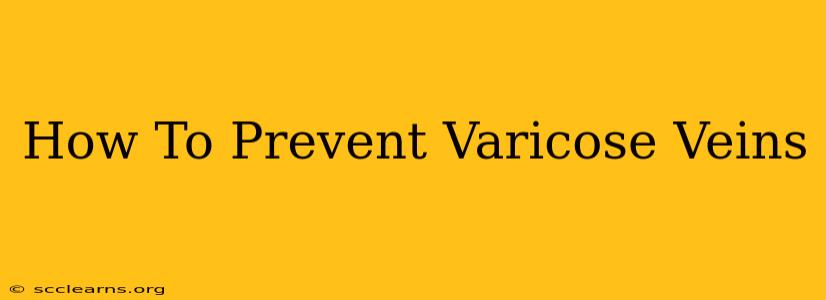Varicose veins, those unsightly and sometimes painful bulging veins, are a common problem affecting millions. While genetics play a role, lifestyle choices significantly impact your risk. This comprehensive guide explores effective strategies to prevent varicose veins and maintain healthy leg circulation.
Understanding Varicose Veins
Before diving into prevention, it's crucial to understand what causes varicose veins. They develop when the valves in your veins weaken, allowing blood to pool and increase pressure within the veins. This pooling causes the veins to become enlarged and twisted. Several factors contribute to this weakening, including:
- Genetics: A family history of varicose veins increases your risk.
- Age: The risk increases with age as vein valves naturally weaken over time.
- Gender: Women are more prone to varicose veins than men, likely due to hormonal influences.
- Obesity: Excess weight puts extra pressure on your veins.
- Pregnancy: Hormonal changes and increased blood volume during pregnancy contribute to vein problems.
- Prolonged Standing or Sitting: Remaining stationary for extended periods restricts blood flow.
- Lack of Exercise: Inactivity hampers circulation.
Effective Strategies to Prevent Varicose Veins
Now that we understand the causes, let's explore practical steps to prevent varicose veins or minimize their development:
1. Maintain a Healthy Weight
Losing even a moderate amount of weight can significantly reduce the pressure on your veins, improving circulation and reducing your risk of varicose veins. A balanced diet and regular exercise are key components of weight management.
2. Exercise Regularly
Regular physical activity boosts circulation, strengthening leg muscles and improving venous return. Aim for at least 30 minutes of moderate-intensity exercise most days of the week. Activities like walking, swimming, and cycling are excellent choices.
3. Elevate Your Legs
Elevating your legs above your heart for 15-20 minutes several times a day helps improve blood flow back to your heart, reducing pressure in the leg veins. This is particularly beneficial after prolonged periods of sitting or standing.
4. Compression Stockings
Compression stockings gently squeeze your legs, improving blood flow and reducing swelling. Consult your doctor to determine the appropriate compression level.
5. Avoid Prolonged Standing or Sitting
If your job requires prolonged standing or sitting, take frequent breaks to move around and stretch your legs. Try to incorporate short walks throughout the day to stimulate circulation.
6. Quit Smoking
Smoking damages blood vessels, making you more susceptible to varicose veins. Quitting smoking is crucial for overall vascular health.
7. Dietary Considerations
A healthy diet rich in fruits, vegetables, and whole grains can support overall vascular health. Limit processed foods, sugary drinks, and excessive salt intake.
8. Regular Checkups
Regular checkups with your doctor are essential, especially if you have a family history of varicose veins or notice any symptoms. Early detection and management can prevent complications.
When to See a Doctor
While preventative measures are crucial, it's important to seek medical attention if you experience:
- Pain or discomfort in your legs
- Swelling in your legs or ankles
- Leg cramps or heaviness
- Skin changes around your veins (e.g., discoloration, ulcers)
Your doctor can accurately diagnose your condition and recommend appropriate treatment options, ranging from lifestyle changes to medical interventions.
By adopting these preventative strategies, you can significantly reduce your risk of developing varicose veins and maintain healthy leg circulation for years to come. Remember, a proactive approach to vein health is crucial for your overall well-being.

